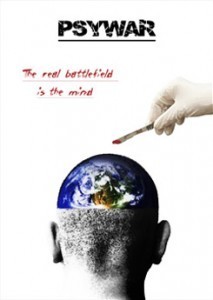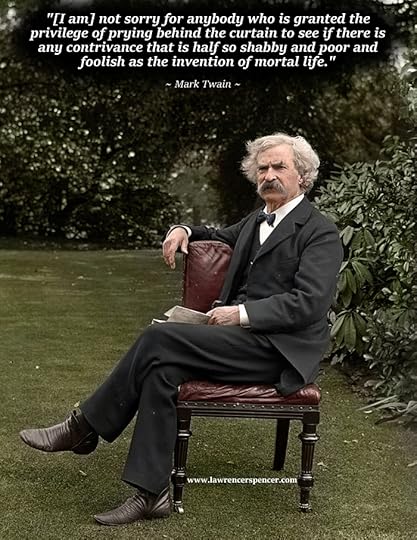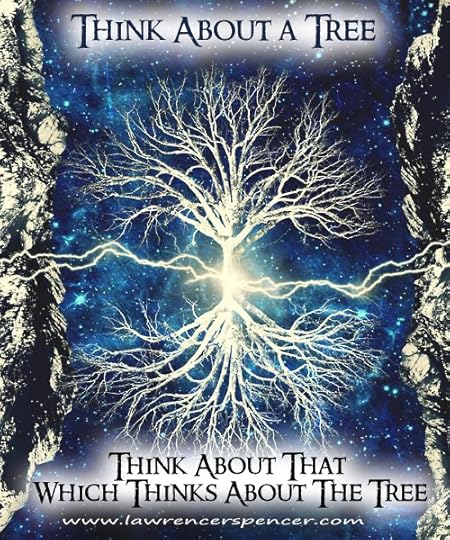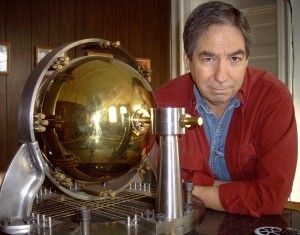Lawrence R. Spencer's Blog, page 514
June 27, 2014
TESLA: STUDENTS GET SURGE OF ELECTRICITY
READ THE ORIGINAL ARTICLE ON THE WEBSITE OF THE U.S. LIBRARY OF CONGRESS
June 26, 2014
TESLA TEXT
June 23, 2014
PSYWAR: The Real Battlefield is the Mind
If you want to understand how the science and art of "public relations" are applied through media advertising campaigns create a FALSE REALITY in the minds of Americans, you must watch this documentary film. We are living in a virtual "matrix" of mind manipulation which is designed to empower the "wealthy elite". This film tracks to the methods of media control developed and paid for by wealthy, aristocratic, Caucasian land owners to control the minds of "the masses", and therefore, each of our lives, our liberties, and the future of all life-forms on our planet. ~ LRS
Watch ALL of the films in this series on the website of the film producer at: http://metanoia-films.org/films/
June 22, 2014
WATER REMEMBERS
These are two important videos that reveal the fact that human thought directly influences the physical structure of our universe, including water. Our bodies and brains are composed of about 80% water! About 80% of our planet is water! Laboratory experiments prove that negative, hateful, destructive vibrations, music, and thoughts instantly change the structure of water. The "memory" of the water structure is permanently altered by our thoughts and behavior. The simple conclusion: bad thoughts = bad water = bad body/brain = bad environment = bad life. Good thoughts = good water = good life.
June 20, 2014
MARK TWAIN: THOUGHTS ABOUT DEATH
Death is the starlit strip between the companionship of yesterday and the reunion of tomorrow.
- on monument erected to Mark Twain & Ossip Gabrilowitsch
All say, "How hard it is that we have to die"-- a strange complaint to come from the mouths of people who have had to live.
- The Tragedy of Pudd'nhead Wilson and the Comedy of the Extraordinary Twins
Whoever has lived long enough to find out what life is, knows how deep a debt of gratitude we owe to Adam, the first great benefactor of our race. He brought death into the world.
- The Tragedy of Pudd'nhead Wilson and the Comedy of the Extraordinary Twins
The Impartial Friend: Death, the only immortal who treats us all alike, whose pity and whose peace and whose refuge are for all--the soiled and the pure, the rich and the poor, the loved and the unloved.
- Mark Twain, last written statement; Moments with Mark Twain, Paine
Pity is for the living, envy is for the dead.
- Following the Equator
Death, the refuge, the solace, the best and kindliest and most prized friend and benefactor of the erring, the forsaken, the old and weary and broken of heart.
- Adam speech, 1883
Life was not a valuable gift, but death was. Life was a fever-dream made up of joys embittered by sorrows, pleasure poisoned by pain; a dream that was a nightmare-confusion of spasmodic and fleeting delights, ecstasies, exultations, happinesses, interspersed with long-drawn miseries, griefs, perils, horrors, disappointments, defeats,humiliations, and despairs--the heaviest curse devisable by divine ingenuity; but death was sweet, death was gentle, death was kind; death healed the bruised spirit and the broken heart, and gave them rest and forgetfulness; death was man's best friend; when man could endure life no longer, death came and set him free.
- Letters from the Earth
Manifestly, dying is nothing to a really great and brave man.
- Letter to Olivia Clemens, 7/1/1885 (referring to General Grant)
How lovely is death; and how niggardly it is doled out.
- Letter to Olivia Clemens, 8/19/1896
It is a solemn thought: dead, the noblest man's meat is inferior to pork.
- More Maxims of Mark, Johnson, 1927
[I am] not sorry for anybody who is granted the privilege of prying behind the curtain to see if there is any contrivance that is half so shabby and poor and foolish as the invention of mortal life.
- Letter to Mary Mason Fairbanks, 1894
I think we never become really and genuinely our entire and honest selves until we are dead--and not then until we have been dead years and years. People ought to start dead, and they would be honest so much earlier.
- Mark Twain in Eruption
To die one's self is a thing that must be easy, & light of consequence; but to lose a part of one's self--well, we know how deep that pang goes, we who have suffered that disaster, received that wound which cannot heal.
- Letter to Will Bowen, 11/4/1888
Favored above Kings and Emperors is the stillborn child.
- Notebook, #42 1898
All people have had ill luck, but Jairus's daughter & Lazarus the worst.
- Notebook #42, 1898
No real estate is permanently valuable but the grave.
- Notebook #42, 1898
Death is so kind, so benignant, to whom he loves; but he goes by us others & will not look our way.
- Letter to W. D. Howells, 12/20/1898
A distinguished man should be as particular about his last words as he is about his last breath. He should write them out on a slip of paper and take the judgment of his friends on them. He should never leave such a thing to the last hour of his life, and trust to an intellectual spurt at the last moment to enable him to say something smart with his latest gasp and launch into eternity with grandeur.
- "The Last Words of Great Men", 1869
Death....a great Leveler -- a king before whose tremendous majesty shades & differences in littleness cannot be discerned -- an Alp from whose summit all small things are the same size.
- Letter to Olivia Clemens, 10/15/1871
June 19, 2014
TREE THOUGHT
"Thought is a force - a manifestation of energy - having a magnet-like power of attraction. You say “I” feel; “I” think; “I” believe; “I” know; “I” will; etc., etc. Now which is the Real Self? The Mental States just mentioned, or the “I” which is the subject or Real Cause of the mental phenomena? It is not the Mind that knows, but the “I” which uses the Mind in order to know. “
~ William Walker Atkinson ~
June 18, 2014
POND SCIENCE INSTITUTE
I had the very great pleasure of speaking with Dale Pond of the Pond Science Institute today. Here is a excerpt from his website (http://pondscienceinstitute.on-rev.com/) which is an amazing resource for students of sciences and spirit. I recommend the Wiki as an excellent resource for research and study. http://pondscienceinstitute.on-rev.com/svpwiki/tiki-index.php ~ LRS
Mission Statement: The Pond Science Institute (PSI) is a place where people can come and learn all aspects of SVP, learn about themselves (physically, mentally and spiritually) and the Cosmos. It is to be a place of healing and refreshing of the spirit; a place for design and prototyping of SVP-type devices, machines and instruments. The institute is to be a center to which people will be drawn and from which will radiate outward the theoretical and practical application of Sacred Science in all its aspects for the benefit of humanity as a whole.
The Pond Science Institute explores and develops the science, art, philosophy and technology of John Worrell Keely, Walter Russell, Phineas Quimby, Nikola Tesla, Edgar Cayce and conventional sciences both in theory and application. Our work is to build bridges between these discoverers and orthodox science and medicine. This underlying interlinking science is called Sympathetic Vibratory Physics (SVP). The basic tenent of SVP is the study of vibration and oscillation as the basic feature of all that there is, visible and invisible. Mind Force is real and is engineerable. A comprehensive expose of SVP is being developed and can be seen here: SVPwiki.
The PSI building has approximately 15,000 sq. ft. on three floors and nearly an acre of land (one half a city block). The facilities include a library, metalworking and wood shops, acoustic lab, museum of New Science, game room, the Russell Brain-Storming Room, diverse offices and kitchen.
June 17, 2014
THE ORIGINAL AUTHOR OF “THE LAW OF ATTRACTION”
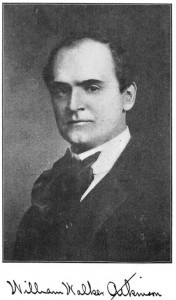 "The great men - the strong men - care nothing for the flock, which so obediently trots along after them. They derive no satisfaction from this thing, which pleases only inferior minds, and gratifies only petty natures and ambitions. The big men — the great spirits of all ages — have derived more satisfaction from that inward conviction of strength and ability which they felt unfolding into activity within themselves, than in the plaudits of the mob, or in the servility of those Imitative creatures who sought to follow in their footsteps.
"The great men - the strong men - care nothing for the flock, which so obediently trots along after them. They derive no satisfaction from this thing, which pleases only inferior minds, and gratifies only petty natures and ambitions. The big men — the great spirits of all ages — have derived more satisfaction from that inward conviction of strength and ability which they felt unfolding into activity within themselves, than in the plaudits of the mob, or in the servility of those Imitative creatures who sought to follow in their footsteps.
And, this thing called Individuality is a real thing. Inherent in each of us, and which may be developed and brought into activity in each one of us if we go about it right. Individuality is the expression of our Self - that Self which is what we mean when we say "I".
Each of us is an Individual - an "I" - differing from every other "I" in the universe, so far as personal expression is concerned. And in the measure that we express and unfold the powers of that "I", so are we great, strong and successful. We all "have it in us" - it depends upon us to get it out into Expression. And, this Individual Expression lies at the heart of the "Secret of Success"."
~ Excerpt from the book "Secret of Success" by William Walker Atkinson, 1906
William Walker Atkinson (December 5, 1862 – November 22, 1932) was an attorney, merchant, publisher, and author, as well as an occultist and an American pioneer of the New Thought movement. He is also known to have been the author of the pseudonymous works attributed to Theron Q. Dumont and Yogi Ramacharaka. Due in part to Atkinson's intense personal secrecy and extensive use of pseudonyms, he is now largely forgotten, despite having written more than 100 books in the last 30 years of his life. His works have remained in print more or less continuously since 1900.
________________________________________
William Walker Atkison Website: http://williamwalkeratkinson.wwwhubs.com/
LINKS to Free On-line books written by WILLIAM WALKER ATKINSON:
Thought Vibration or the Law of Attraction in the Thought World by William Walker Atkinson
Reincarnation and the Law of Karma, by William Walker Atkinson
( http://www.gutenberg.org/files/26364/26364-h/26364-h.htm )
Memory: How to Develop, Train and Use It, by William Walker Atkinson
http://www.gutenberg.org/files/41478/41478-h/41478-h.htm
Practical Mental Influence by William Walker Atkinson - free online edition
Practical Mind Reading by William Walker Atkinson - free online edition
The Art and Science of Personal Magnetism by Theron Q. Dumont free online edition
Mystic Christianity by Yogi Ramacharaka free online edition
Mystic Christianity by Yogi Ramacharaka — Read Online, Flash Version
Science of Breath by Yogi Ramacharaka free online edition
The Hindu-Yogi Science of Breath by Yogi Ramacharaka — Read Online, Flash Version
The Yogi Philosophy by Yogi Ramacharaka free online edition
Gnani Yoga by Yogi Ramacharaka — Read Online, Flash Version
Hatha Yoga by Yogi Ramacharaka free online edition
Raja Yoga by Yogi Ramacharaka — Read Online, Flash Version
The Kybalion Resource Page - features online versions of The Kybalion
The Arcane Teaching
June 15, 2014
I AM “A GOD”….BUT NOT “THE GOD”
THIS IS ONE OF MY TOP TEN MOVIE SCENES OF ALL TIME (at least of the movies I've seen in my lifetime.)
BILL MURRAY IN "GROUNDHOG DAY"
June 13, 2014
LIFE AS A HOLOGRAM
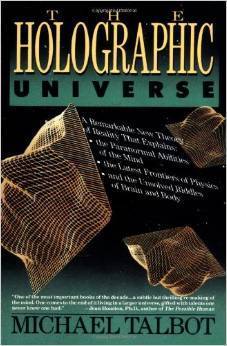 Michael Talbot (1953-1992), was the author of several books on holograms and quantum mechanics, and their relationship to ancient mysticism and the theoretical models of reality. Talbot explored the works of physicist David Bohm and neurophysiologist Karl Pribram, who independently reached the conclusion that the universe operates on a holographic model. In Talbot's book, The Holographic Universe, Talbot also arrives at this conclusion and maintains that the holographic model might also explain numerous paranormal and unusual phenomena as well as offer a basis for mystical experiences.
Michael Talbot (1953-1992), was the author of several books on holograms and quantum mechanics, and their relationship to ancient mysticism and the theoretical models of reality. Talbot explored the works of physicist David Bohm and neurophysiologist Karl Pribram, who independently reached the conclusion that the universe operates on a holographic model. In Talbot's book, The Holographic Universe, Talbot also arrives at this conclusion and maintains that the holographic model might also explain numerous paranormal and unusual phenomena as well as offer a basis for mystical experiences.
In 1982, at the University of Paris a research team led by physicist Alain Aspect performed what may turn out to be one of the most important experiments of the 20th century. Aspect's experiment was related to the EPR Experiment, a consciousness experiment which had been devised by Albert Einstein, and his colleagues, Poldlsky and Rosen, in order to disprove Quantum Mechanics on the basis of the Pauli Exclusion Principle contradicting Special Relativity.
Aspect and his team discovered that under certain circumstances subatomic particles such as electrons are able to instantaneously communicate with each other regardless of the distance separating them. It doesn't matter whether they are 10 feet or 10 billion miles apart. Somehow each particle always seemed to know what the other was doing. This feat violates Einstein's long-held tenet that no communication can travel faster than the speed of light which is tantamount to breaking the time barrier. This daunting prospect has caused some physicists to try to come up with elaborate ways to explain away Aspect's findings. But it has inspired others to offer even more radical explanations.
University of London physicist David Bohm, for example, believes Aspect's findings imply that objective reality does not exist, that despite its apparent solidity the universe is at heart a phantasm, a gigantic and splendidly detailed hologram. To understand why Bohm makes this startling assertion, one must first understand a little about holograms. A hologram is a three- dimensional photograph made with the aid of a laser. To make a hologram, the object to be photographed is first bathed in the light of a laser beam. Then a second laser beam is bounced off the reflected light of the first and the resulting interference pattern (the area where the two laser beams commingle) is captured on film.
When the film is developed, it looks like a meaningless swirl of light and dark lines. But as soon as the developed film is illuminated by another laser beam, a three-dimensional image of the original object appears. The three-dimensionality of such images is not the only remarkable characteristic of holograms. If a hologram of a rose is cut in half and then illuminated by a laser, each half will still be found to contain the entire image of the rose. Even if the halves are divided again, each snippet of film will always be found to contain a smaller but intact version of the original image. Unlike normal photographs, every part of a hologram contains all the information possessed by the whole.
The "whole in every part" nature of a hologram provides us with an entirely new way of understanding organization and order. For most of its history, Western science has labored under the bias that the best way to understand a physical phenomenon, whether a frog or an atom, is to dissect it and study its respective parts. A hologram teaches us that some things in the universe may not lend themselves to this approach. If we try to take apart something constructed holographically, we will not get the pieces of which it is made, we will only get smaller wholes.
This insight suggested to Bohm another way of understanding Aspect's discovery. Bohm believes the reason subatomic particles are able to remain in contact with one another regardless of the distance separating them is not because they are sending some sort of mysterious signal back and forth, but because their separateness is an illusion. He argues that at some deeper level of reality such particles are not individual entities, but are actually extensions of the same fundamental something.
This fundamental connectedness would correlate with The Fifth Element, and its mathematical proof of all aspects of the universe being energetically connected - Hal Puthoff's assertion in his work on Zero-Point Energy of all charges in the universe being connected and that further mass is in all likelihood an illusion as well -- and both of these modern day theories of physics being in accordance with ancient traditions and philosophies, which claim the same connectedness of the diverse parts of the universe.
To enable people to better visualize what he means, Bohm offers the following illustration. Imagine an aquarium containing a fish. Imagine also that you are unable to see the aquarium directly and your knowledge about it and what it contains comes from two television cameras, one directed at the aquarium's front and the other directed at its side. As you stare at the two television monitors, you might assume that the fish on each of the screens are separate entities. After all, because the cameras are set at different angles, each of the images will be slightly different. But as you continue to watch the two fish, you will eventually become aware that there is a certain relationship between them. When one turns, the other also makes a slightly different but corresponding turn; when one faces the front, the other always faces toward the side. If you remain unaware of the full scope of the situation, you might even conclude that the fish must be instantaneously communicating with one another, but this is clearly not the case. This, says Bohm, is precisely what is going on between the subatomic particles in Aspect's experiment.
According to Bohm, the apparent faster-than-light connection between subatomic particles is really telling us that there is a deeper level of reality we are not privy to, a more complex dimension beyond our own that is analogous to the aquarium. And, he adds, we view objects such as subatomic particles as separate from one another because we are seeing only a portion of their reality. Such particles are not separate "parts", but facets of a deeper and more underlying unity that is ultimately as holographic and indivisible as the previously mentioned rose. And since everything in physical reality is comprised of these "eidolons", the universe is itself a projection, a hologram.
In addition to its phantom-like nature, such a universe would possess other rather startling features. If the apparent separateness of subatomic particles is illusory, it means that at a deeper level of reality all things in the universe are infinitely interconnected. The electrons in a carbon atom in the human brain are connected to the subatomic particles that comprise every salmon that swims, every heart that beats, and every star that shimmers in the sky. Everything interpenetrates everything, and although human nature may seek to categorize and pigeonhole and subdivide, the various phenomena of the universe, all apportionments are of necessity artificial and all of nature is ultimately a seamless web.
Superhologram
In a holographic universe, even time and space could no longer be viewed as fundamentals. Because concepts such as location break down in a universe in which nothing is truly separate from anything else, time and three-dimensional space, like the images of the fish on the TV monitors, would also have to be viewed as projections of this deeper order. At its deeper level reality is a sort of superhologram in which the past, present, and future all exist simultaneously. This suggests that given the proper tools it might even be possible to someday reach into the superholographic level of reality and pluck out scenes from the long-forgotten past.
What else the superhologram contains is an open-ended question. Allowing, for the sake of argument, that the superhologram is the matrix that has given birth to everything in our universe, at the very least it contains every subatomic particle that has been or will be -- every configuration of matter and energy that is possible, from snowflakes to quasars, from bluu whales to gamma rays. It must be seen as a sort of cosmic storehouse of "All That Is."
Although Bohm concedes that we have no way of knowing what else might lie hidden in the superhologram, he does venture to say that we have no reason to assume it does not contain more. Or as he puts it, perhaps the superholographic level of reality is a "mere stage" beyond which lies "an infinity of further development".
Karl Pribram
Bohm is not the only researcher who has found evidence that the universe is a hologram. Working independently in the field of brain research, Standford neurophysiologist Karl Pribram has also become persuaded of the holographic nature of reality. Pribram was drawn to the holographic model by the puzzle of how and where memories are stored in the brain. For decades numerous studies have shown that rather than being confined to a specific location, memories are dispersed throughout the brain.
In the 1960s Pribram encountered the concept of holography and realized he had found the explanation brain scientists had been looking for. Pribram believes memories are encoded not in neurons, or small groupings of neurons, but in patterns of nerve impulses that crisscross the entire brain in the same way that patterns of laser light interference crisscross the entire area of a piece of film containing a holographic image. In other words, Pribram believes the brain is itself a hologram.
Pribram's theory also explains how the human brain can store so many memories in so little space. It has been estimated that the human brain has the capacity to memorize something on the order of 10 billion bits of information during the average human lifetime.
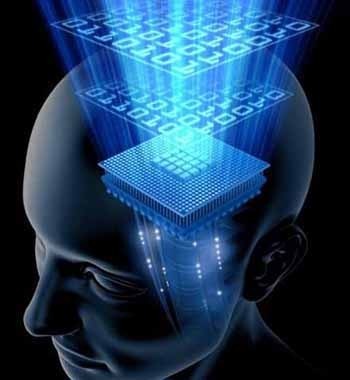
The brain is an electrochemical machine that stores information - binary codeOne of the most amazing things about the human thinking process is that every piece of information seems instantly cross-correlated with every other piece of information - another feature intrinsic to the hologram. Because every portion of a hologram is infinitely interconnected with ever other portion, it is perhaps nature's supreme example of a cross-correlated system.
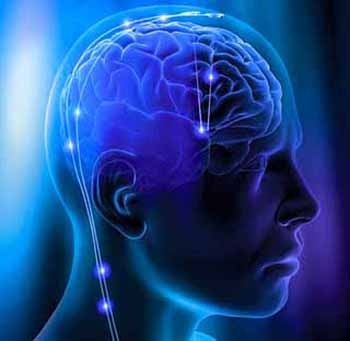 The storage of memory is not the only neurophysiological puzzle that becomes more tractable in light of Pribram's holographic model of the brain. Another is how the brain is able to translate the avalanche of frequencies it receives via the senses (light frequencies, sound frequencies, and so on) into the concrete world of our perceptions. Encoding and decoding frequencies is precisely what a hologram does best. Just as a hologram functions as a sort of lens, a translating device able to convert an apparently meaningless blur of frequencies into a coherent image, Pribram believes the brain also comprises a lens and uses holographic principles to mathematically convert the frequencies it receives through he senses into the inner world of our perceptions. An impressive body of evidence suggests that the brain uses holographic principles to perform its operations. Pribram's theory, in fact, has gained increasing support among neurophysiologists.
The storage of memory is not the only neurophysiological puzzle that becomes more tractable in light of Pribram's holographic model of the brain. Another is how the brain is able to translate the avalanche of frequencies it receives via the senses (light frequencies, sound frequencies, and so on) into the concrete world of our perceptions. Encoding and decoding frequencies is precisely what a hologram does best. Just as a hologram functions as a sort of lens, a translating device able to convert an apparently meaningless blur of frequencies into a coherent image, Pribram believes the brain also comprises a lens and uses holographic principles to mathematically convert the frequencies it receives through he senses into the inner world of our perceptions. An impressive body of evidence suggests that the brain uses holographic principles to perform its operations. Pribram's theory, in fact, has gained increasing support among neurophysiologists.
Holophonics
Argentinian-Italian researcher Hugo Zucarelli recently extended the holographic model into the world of acoustic phenomena. Puzzled by the fact that humans can locate the source of sounds without moving their heads, even if they only possess hearing in one ear, Zucarelli discovered that holographic principles can explain this ability. Zucarelli has also developed the technology of holophonic sound, a recording technique able to reproduce acoustic situations with an almost uncanny realism.
Pribram's belief that our brains mathematically construct "hard" reality by relying on input from a frequency domain has also received a good deal of experimental support. It has been found that each of our senses is sensitive to a much broader range of frequencies than was previously suspected. Researchers have discovered, for instance, that our visual systems are sensitive to sound frequencies, that our sense of smell is in part dependent on what are now called "cosmic frequencies", and that even the cells in our bodies are sensitive to a broad range of frequencies. Such findings suggest that it is only in the holographic domain of consciousness that such frequencies are sorted out and divided up into conventional perceptions.
But the most mind-boggling aspect of Pribram's holographic model of the brain is what happens when it is put together with Bohm's theory. For if the concreteness of the world is but a secondary reality and what is "there" is actually a holographic blur of frequencies, and if the brain is also a hologram and only selects some of the frequencies out of this blur and mathematically transforms them into sensory perceptions, what becomes of objective reality?
Put quite simply, it ceases to exist. As the religions of the East have long upheld, the material world is Maya, an illusion, and although we may think we are physical beings moving through a physical world, this too is an illusion. We are really "receivers" floating through a kaleidoscopic sea of frequency, and what we extract from this sea and transmogrify into physical reality is but one channel from many extracted out of the superhologram.
This striking new picture of reality, the synthesis of Bohm and Pribram's views, has come to be called the Holographic Paradigm, and although many scientists have greeted it with skepticism, it has galvanized others. A small but growing group of researchers believe it may be the most accurate model of reality science has arrived at thus far. More than that, some believe it may solve some mysteries that have never before been explainable by science and even establish the paranormal as a part of nature. Numerous researchers, including Bohm and Pribram, have noted that many para-psychological phenomena become much more understandable in terms of the holographic paradigm.
In a universe in which individual brains are actually indivisible portions of the greater hologram and everything is infinitely interconnected, telepathy may merely be the accessing of the holographic level. It is obviously much easier to understand how information can travel from the mind of individual 'A' to that of individual 'B' at a far distance point and helps to understand a number of unsolved puzzles in psychology.
Stansilov Grof
In particular, Stansilov Grof feels the holographic paradigm offers a model for understanding many of the baffling phenomena experienced by individuals during altered states of consciousness.
In the 1950s, while conducting research into the beliefs of LSD as a psychotherapeutic tool, Grof had one female patient who suddenly became convinced she had assumed the identity of a female of a species of prehistoric reptile. During the course of her hallucination, she not only gave a richly detailed description of what it felt like to be encapsulated in such a form, but noted that the portion of the male of the species anatomy was a patch of colored scales on the side of its head. What was startling to Grof was that although the woman had no prior knowledge about such things, a conversation with a zoologist later confirmed that in certain species of reptiles colored areas on the head do indeed play an important role as triggers of sexual arousal.
The woman's experience was not unique. During the course of his research, Grof encountered examples of patients regressing and identifying with virtually every species on the evolutionary tree (research findings which helped influence the man-into-ape scene in the movie, Altered States). Moreover, he found that such experiences frequently contained obscure zoological details which turned out to be accurate.
Regressions into the animal kingdom were not the only puzzling psychological phenomena Grof encountered. He also had patients who appeared to tap into some sort of collective or racial unconscious. Individuals with little or no education suddenly gave detailed descriptions of Zoroastrian funerary practices and scenes from Hindu mythology. In other categories of experience, individuals gave persuasive accounts of out-of-body journeys, of precognitive glimpses of the future, of regressions into apparent past-life incarnations.
In later research, Grof found the same range of phenomena manifested in therapy sessions which did not involve the use of drugs. Because the common element in such experiences appeared to be the transcending of an individual's consciousness beyond the usual boundaries of ego and/or limitations of space and time, Grof called such manifestations transpersonal experiences, and in the late '60s he helped found a branch of psychology called transpersonal psychology devoted entirely to their study. Although Grof's newly founded Association of Transpersonal Psychology garnered a rapidly growing group of like-minded professionals and has become a respected branch of psychology, for years neither Grof or any of his colleagues were able to offer a mechanism for explaining the bizarre psychological phenomena they were witnessing. But that has changed with the advent of the holographic paradigm.
As Grof noted, if the mind is actually part of a continuum, a labyrinth that is connected not only to every other mind that exists or has existed, but to every atom, organism, and region in the vastness of space and time itself, the fact that it is able to occasionally make forays into the labyrinth and have transpersonal experiences no longer seems so strange. Perhaps, in Creating Reality, we have already become - as in Star Trek, The Next Generation - a Q of the Continuum or we are part of a consciousness virtual reality experiment.
In his book Gifts of Unknown Things, biologist Lyall Watson describes his encounter with an Indonesian shaman woman who, by performing a ritual dance, was able to make an entire grove of trees instantly vanish into thin air. Watson relates that as he and another astonished onlooker continued to watch the woman, she caused the trees to reappear, then click off again and on again several times in succession. Although current scientific understanding is incapable of explaining such events, experiences like this become more tenable if hard reality is only a holographic projection.
Perhaps we agree on what is 'there' or 'not there' because what we call consensus reality is formulated and ratified at the level of the human unconscious at which all minds are infinitely interconnected. If this is true, it is the most profound implication of the holographic paradigm of all, for it means that experiences such as Watson's are not commonplace only because we have not programmed our minds with the beliefs that would make them so.
In a holographic universe there are no limits to the extent to which we can alter the fabric of reality.
What we perceive as reality is only a canvas waiting for us to draw upon it any picture we want. Anything is possible, from bending spoons with the power of the mind to events experienced by Carlos Castaneda during his encounters with the Yaqui brujo don Juan, for Magic is our birthright, no more or less miraculous than our ability to compute the reality we want when we are in our dreams.
Indeed, even our most fundamental notions about reality become suspect, for in a holographic universe, as Pribram has pointed out, even random events would have to be seen as based on holographic principles and therefore determined.
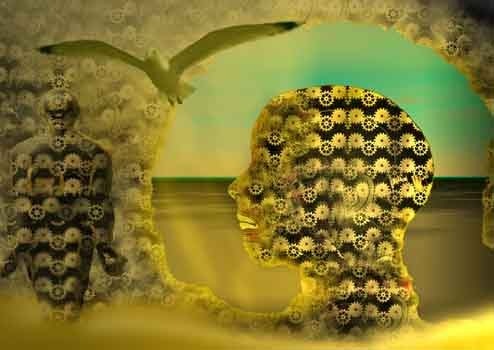 Synchronicity Principal suddenly makes sense, and everything in reality would have to be seen as a metaphor. Even the most haphazard events would express some underlying symmetry.
Synchronicity Principal suddenly makes sense, and everything in reality would have to be seen as a metaphor. Even the most haphazard events would express some underlying symmetry.
Whether Bohm and Pribram's holographic paradigm becomes accepted in science or dies an ignoble death remains to be seen, but it is safe to say that it has already had an influence on the thinking of many scientists. And even if it is found that the holographic model does not provide the best explanation for the instantaneous communications that seem to be passing back and forth between subatomic particles, at the very least, as noted by Basil Hiley, a physicist at Birbeck College in London, Aspect's findings indicate that we must be prepared to consider radically new views of reality."___________________
(THIS ARTICLE IS REPOSTED FROM http://www.crystalinks.com/holographicuniverse.html )



